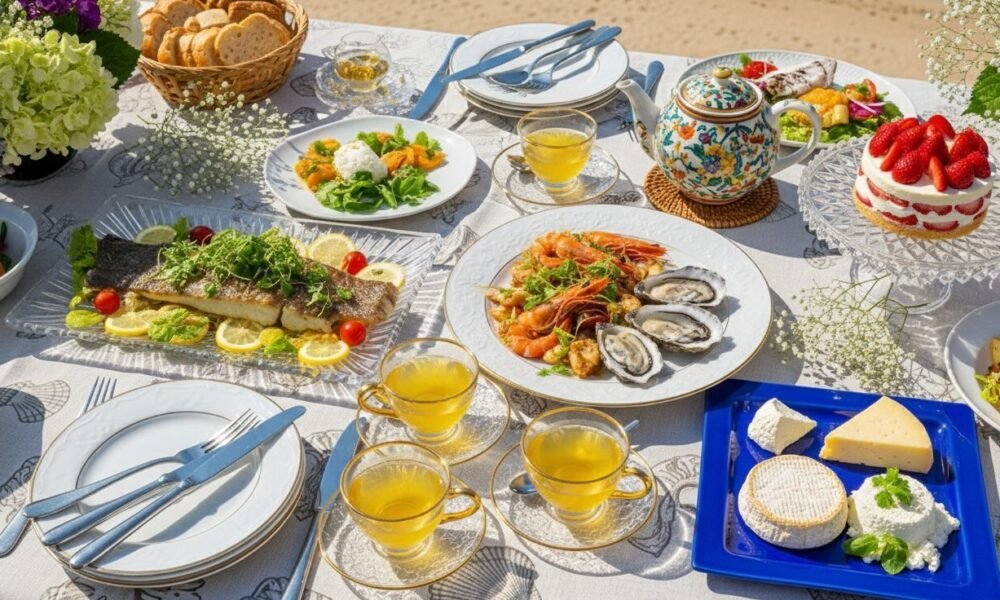
What to Pair White Tea With: Tea Pairing Tips for Ideal Food Combinations
Index
This elegant delicate tea, made from the young buds of the Camellia sinensis plant, offers soft floral notes and a natural sweetness that shine when you match it with the right foods.
This guide will show you which foods let white tea’s subtle flavors stand out, whether you’re relaxing at home or hosting friends.
Key Takeaways
- White tea, including Silver Needle and White Peony varieties, pairs best with mild foods like soft cheeses, fruit-filled pastries, oatmeal, and gentle breakfast items due to its subtle flavor.
- Expert tastings at the French Cheese Board in Soho show that Beaufort and triple-cream cheeses complement white tea’s floral notes without overpowering its aroma or taste.
- Seafood such as steamed shrimp, oysters, and mild white fish enhance the delicate sweetness of Silver Needle or Nepal White teas when seasoned lightly.
- Avoid pairing white tea with overly spiced dishes or heavy sauces since strong flavors can mask its natural floral notes and minimal astringency.
- Proper brewing, using weighed leaves and correct water temperature under boiling for most types, ensures you enjoy all layers of flavor in every cup.
What Are the Flavor Characteristics of White Tea?
White tea brings a soft, airy sweetness to your cup.
You’ll notice it feels light on your palate, never harsh or bitter. These gentle qualities make pairing white tea with food both fun and a bit of a challenge. The key is to look for foods that won’t overpower what makes this tea so special.
Delicate and Subtle Sweetness
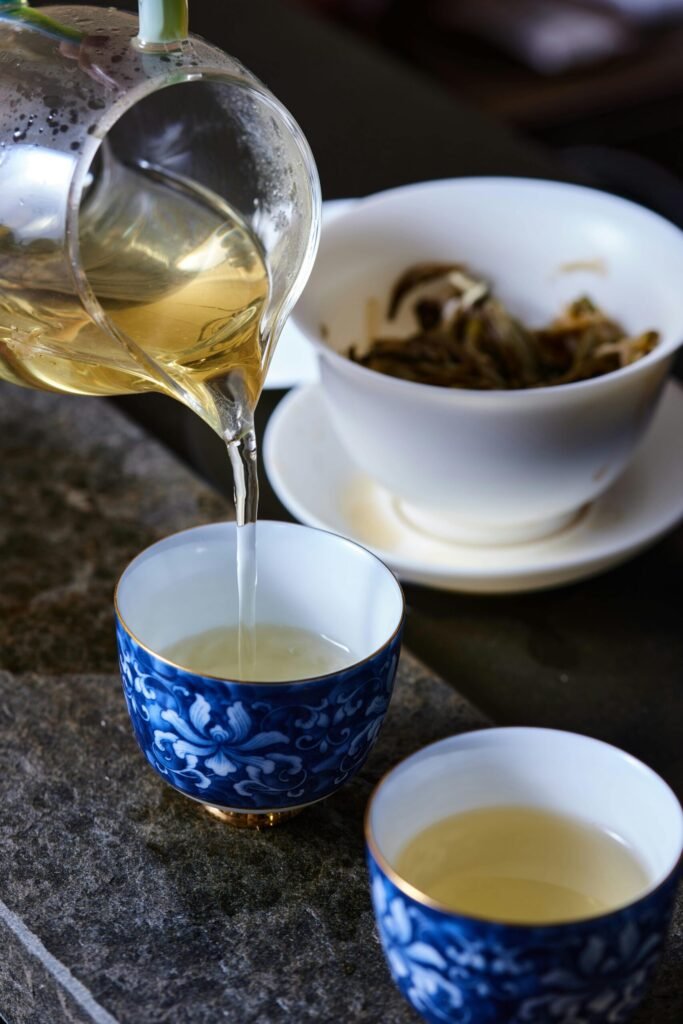
Silver Needle white tea, also known as Baihao Yinzhen, stands out for its natural sweetness.
This tea is made entirely from the unopened buds of the tea plant. Its sweetness appears light and floral with hints of melon or pear, creating what many tea enthusiasts describe as honeysuckle essence.
Nepal White shines with a pleasant sweet note and mild melon flavor.
It pairs well with gentle foods like a bowl of yogurt or thin slices of ripe peach. According to tea experts at Rishi Tea, it takes over 30,000 hand-plucked buds to produce just one kilogram of Silver Needle, which explains why this tea commands such careful attention when pairing.
Certain foods enhance the subtle flavors in these teas without overpowering them.
Creamy white chocolate matches beautifully because it melts smoothly alongside the soft finish of white tea on your palate. Mild cheeses such as Beaufort create harmony with these subdued sweet notes instead of masking them.
Light pastries, especially those featuring honey or vanilla flavors, make perfect partners for this kind of pairing guide.
White tea’s delicate sweetness blossoms when shared with lightly flavored treats.
Proper brewing matters to bring out this character.
Weighing your leaves and using correct water temperatures ensures you enjoy all layers in each infusion. The sweet flavor profile sometimes contains faint fruit or cucumber accents that lift both food and drink alike during afternoon tea sessions or special tastings at home.
Floral and Hay-Like Notes
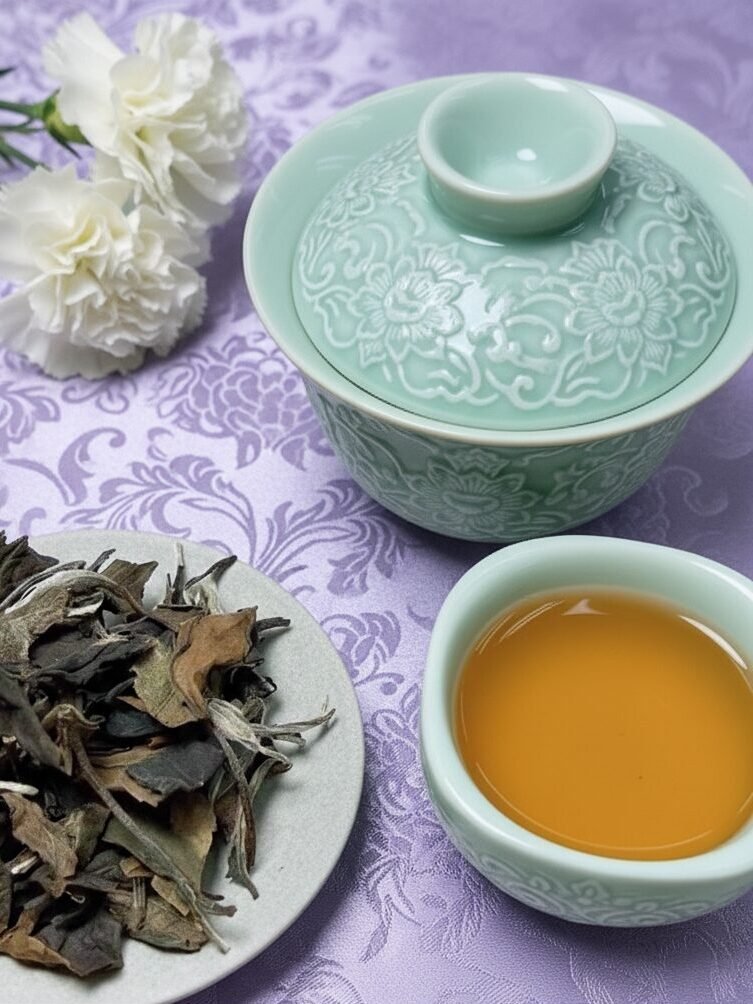
White tea’s floral and hay-like notes come from its minimal processing.
The fine white hairs on each tea bud give Bai Hao Yin Zhen, also called Silver Needle, its famous elegant aromas. After steeping, you’ll notice an aroma similar to fresh-cut hay mixed with light blossom scents.
These qualities show up most strongly in teas made from Fuding or Zhenghe regions of China.
Many types of white tea develop stronger floral and grassy undertones as they age over several years. Aged varieties bring out even more pronounced hay-like flavors that blend well with vegetable salads or goat cheese during a thoughtful tea and food pairing session.
Mild vegetables can boost the natural sweetness of the brew.
Fresh cheeses match the complex aromatic profile found in both foods and drink. This style of flavor makes white tea pairings a favorite choice among sommeliers who want to highlight delicate flavors in their guide to pairing options.
Minimal Astringency
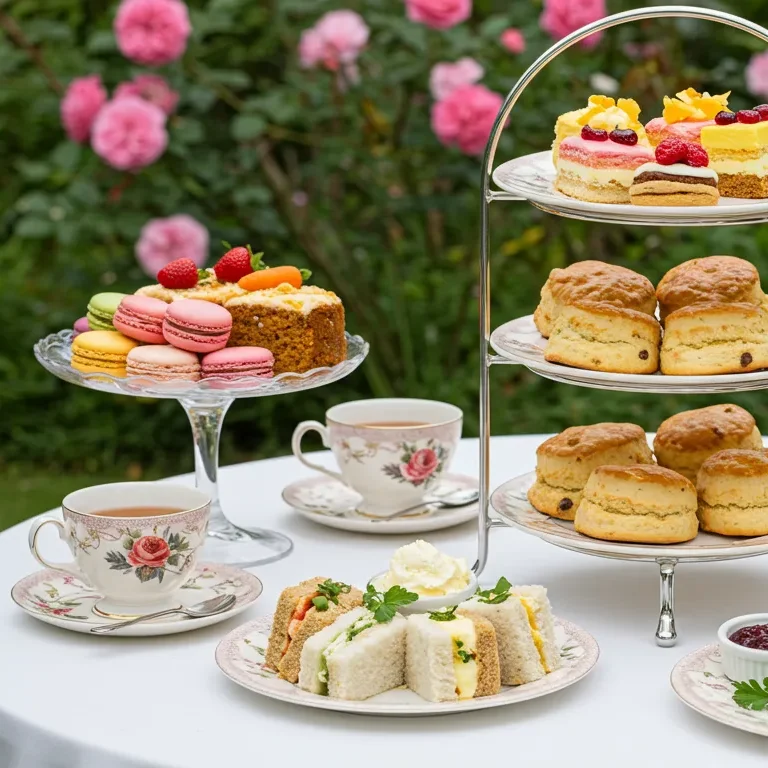
Minimal astringency sets white tea apart from green tea and black teas.
The gentle processing of leaves preserves a smooth texture. The flavor rarely turns bitter even with longer steeping times, which is why tea enthusiasts note that white tea can be steeped in 60°F to 185°F (71°C to 85°C) – for delicate, subtle flavors, and up to 212°F (100°C) – for bolder flavor profiles, with shorter steep times.
Pairing tea with food becomes easier because the mildness never dominates light snacks or delicate desserts.
Think of meringues and honey cakes. This low level of astringency allows you to match white tea with nutty foods such as basmati rice or fresh fruit without overpowering their subtle flavors.
Mild seafood, cucumber sandwiches, and yogurt bowls also pair well since heavy tannins stay absent from each sip.
Tea lovers who enjoy easy-drinking beverages often find that this quality makes it perfect for thoughtful combinations during any meal or snack time.
Why Does White Tea Require Gentle Food Pairings?
White tea’s flavor comes from the youngest tea leaves and buds.
Farmers carefully pick them to create a light, nuanced taste. This delicate process preserves floral and fruity notes that set white tea apart from other types of tea like oolong or gunpowder green.
Strong foods can easily overpower these flavors.
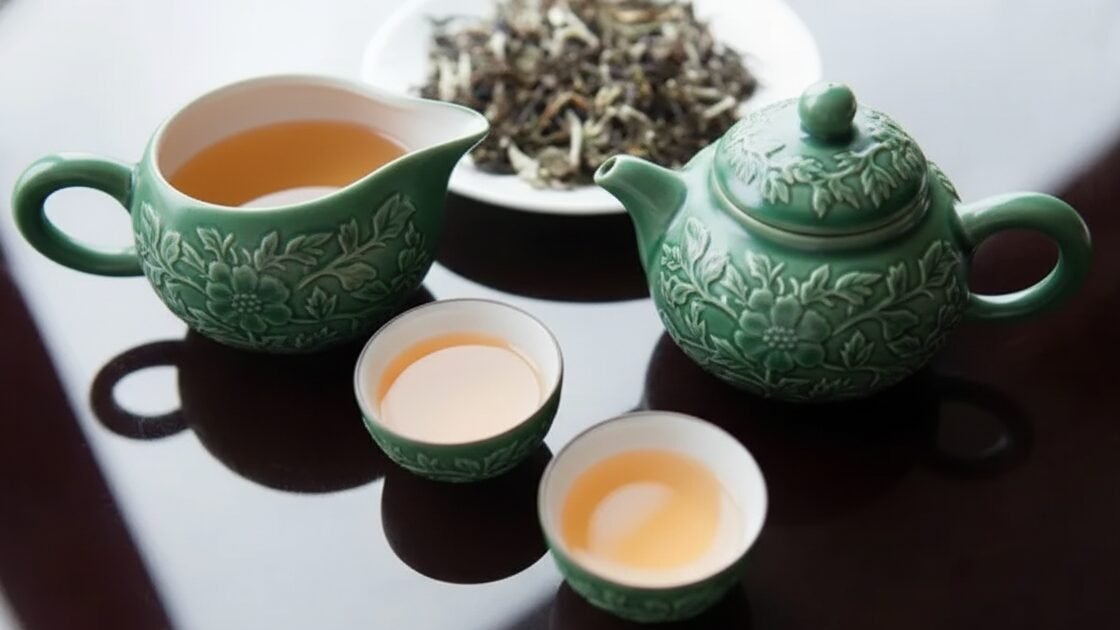
This makes gentle food pairings essential for enjoying the subtle sweetness of white tea. Pairings with mild cheese or simple pastries allow you to appreciate the complexity without dulling its essence.
The mild nature of white tea means it contains almost no bitterness and low astringency.
Its mouthfeel is soft and smooth rather than sharp. Foods with bold spices or heavy richness dominate this intricate balance, masking key aromas such as hay-like freshness or sweet citrus highlights found in varieties like Silver Needle or White Peony.
To match the luxury of rare teas, we must approach each pairing as if curating art, thoughtfully choosing what will enhance but never overshadow.
Even proper brewing methods echo this need for care.
Oversteeping disrupts both aroma and flavor harmony. Lighter fare supports white tea’s natural elegance best. Young cheeses lend creaminess without weighing down the cup while fresh berries accentuate its fruity undertones.
What Foods Pair Best with White Tea?
You can discover many tea and food combinations that pair beautifully with the subtle flavor of white tea.
Keep reading to find matches that will elevate your next cup.
White Tea with Light Snacks
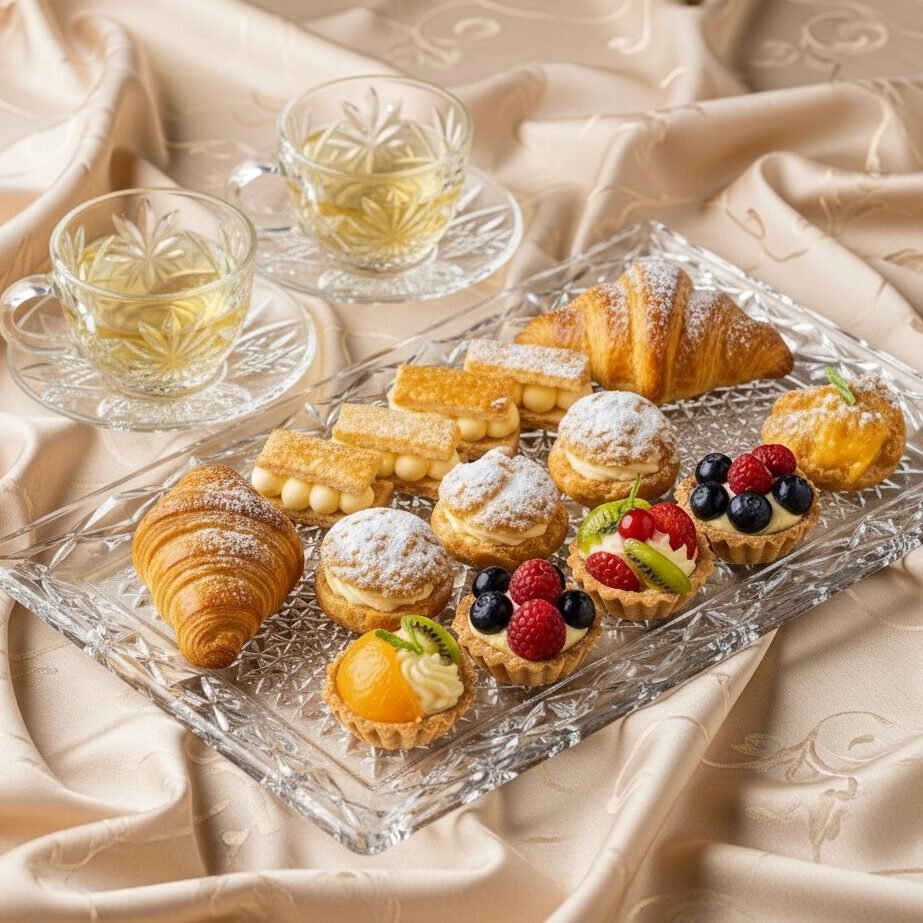
Oatmeal delivers an earthy taste that supports the subtle flavor of white tea.
Yogurt, with its sweet-savory richness, pairs well during breakfast or as a midday snack. Mild vegetables like cucumber or lettuce in salads highlight the gentle palate of delicate tea without overwhelming it.
Lightly flavored crackers and toast offer unobtrusive options for pairing with white tea.
Their simple texture lets floral and hay-like notes shine. Pastry desserts containing fruit, such as apricot danishes or strawberry tarts, make perfect companions by providing fruity flavors that match the mellow character of this beverage.
Basmati rice also functions well as either a light snack or mild side dish.
Its softness complements both iced tea and hot brews with minimal astringency. Non-acidic fruits like mango and blueberry help preserve the integrity of white tea’s delicate taste profile.
Slightly chilled berries bring out the antioxidant properties found in many types of white teas while keeping bitterness at bay.
These food combinations create ideal starting points before moving to mild seafood pairings next in your exploration.
White Tea with Mild Seafood
White tea pairs beautifully with mild seafood like steamed shrimp, oysters, and white fish.
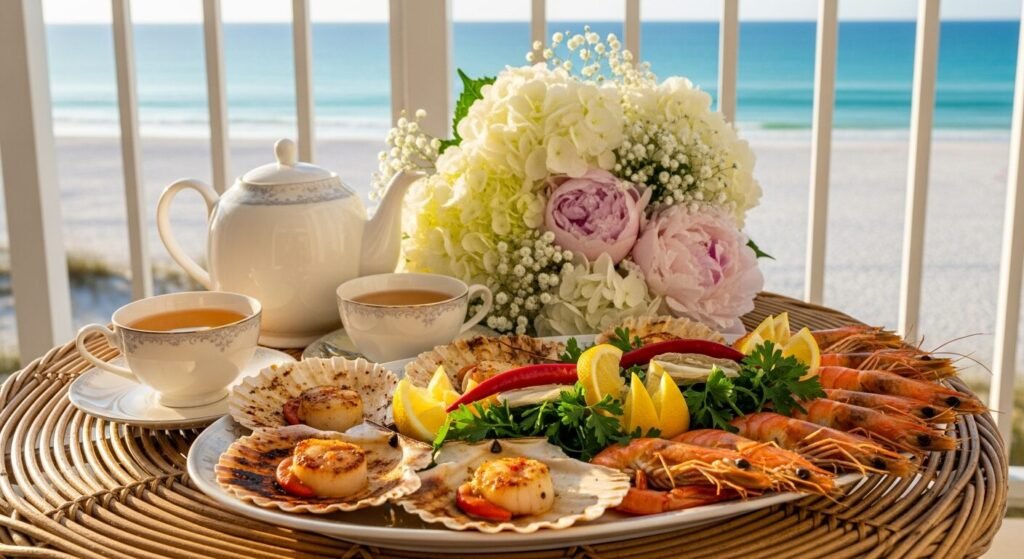
Delicate flavors in these dishes allow the subtle sweetness and floral notes of the tea to shine. Steamed shrimp brings a gentle taste that matches the low astringency of premium Silver Needle or White Peony teas.
Oysters offer briny tones that interact well with white tea’s clean finish and smooth texture.
Seafood with minimal seasoning lets both the food and beverage stay balanced on your palate. Young cheeses or blue goat cheese can act as bold companions for those who seek intense contrasts, though most find creamy cheeses best for enhancing mellow undertones.
The refreshing quality of white tea makes it an ideal palate cleanser between bites.
It preserves every nuanced note from both seafood and leaf infusion during your next perfect pairing session.
White Tea with Delicate Desserts
Pair white tea with desserts that have light and subtle flavors to enhance the taste of the tea.

Strawberry shortcake stands out. Its soft, fruity notes align well with the floral character of many white teas.
Silver Needle or Nepal White varieties accentuate melon and lychee slices.
These fruits echo natural fruitiness while keeping each sip refreshing. Opt for vanilla-based desserts such as meringues or honey cakes. These options offer mild sweetness without overpowering the delicate aroma of your cup.
Pastries filled with fruit also pair well.
They add a gentle tartness that complements both Silver Needle and White Peony teas. Instead of dark chocolate, choose creamy white chocolate. It matches the smooth texture and subtle flavors found in top-quality white teas and creates an ideal food pairing guide for those new to tea combinations.
Which White Tea Varieties Pair with Which Foods?
Different types of white tea pair well with certain foods, thanks to their unique flavors and aromas.
Explore how the subtle taste of silver needle tea or the bolder notes in Baimudan tea enhance your favorite dishes.
Silver Needle Food Pairing
Silver Needle, often called Baihao Yinzhen, stands out as the most luxurious white tea.
Only full buds covered in fine white down make up this prized variety from Fuding and Zhenghe in Yunnan Province, China. The subtle sweetness and delicate floral notes shine best with gentle food pairings that respect the flavors of the tea.
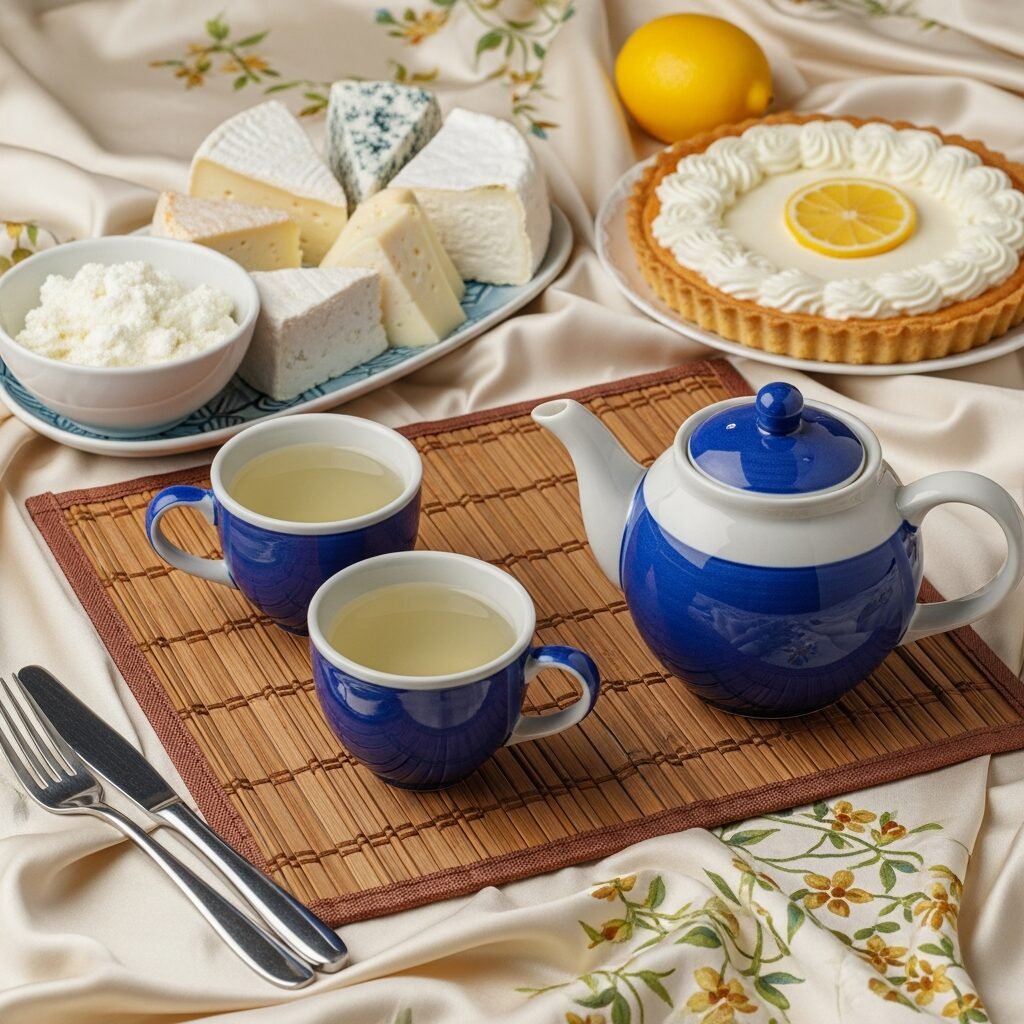
Experts found that Silver Needle pairs well with light, mild cheeses such as Beaufort cheese from France.
During a tasting session using three professional cup sets, Beaufort complemented Silver Needle without overpowering its aroma or flavor profile. Soft young cheeses or ricotta also go well with these subtle tea notes.
Light fruity desserts like lemon cream tart or poached pears match well with Silver Needle’s clean finish and soft sweetness.
Both allow the taste of white tea to linger on your palate. Fruits like orange slices or melon cubes can be paired for an uplifting experience since they highlight the gentle sweetness of Silver Needle without masking it.
Avoid pairing this tea with strong herbs such as ginger or mentha.
Their assertive flavors may clash rather than harmonize. With careful selection, you will find that each bite enhances your appreciation for the unique qualities of this exquisite Chinese tea beverage.
White Peony Food Pairing
Moving from the gentle, airy profile of Silver Needle, White Peony (Bai Mudan) invites tea drinkers to explore a slightly fuller taste.
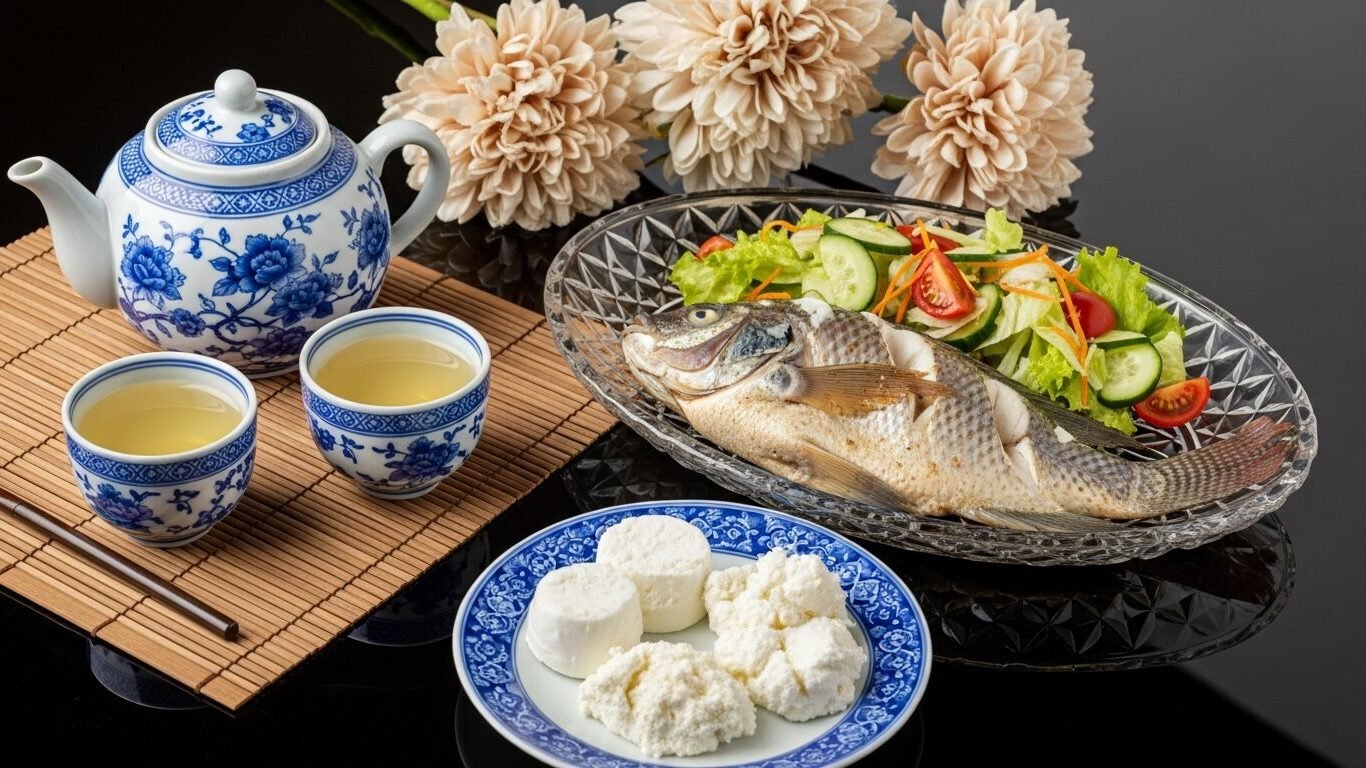
This variety uses both buds and young leaves. It goes well with mild fish dishes like steamed tilapia or cod and enhances light vegetable salads.
Soft cheeses such as fresh goat cheese or ricotta pair well with White Peony.
This works due to its floral sweetness and minimal astringency. You can also match White Peony with light pastries or basmati rice for a balanced experience.
Its subtle fruity flavor complements desserts featuring melon or lychee.
This makes it perfect for fruit-based sweets. Grown in China since the early 20th century, this tea pairs especially well with foods that have mild flavors rather than strong spices or heavy sauces.
Experimenting with these combinations helps you discover how this white tea is a versatile partner at any table.
Aged White Tea Food Pairing
Aged white tea, such as Midnight White from In Pursuit of Tea, reveals deep hay-like and floral notes with pronounced honey aromas.

This complexity matches well with richer mild foods that don’t overpower its flavor. Triple-cream cheeses like Brillat-Savarin make an excellent choice. Their buttery texture highlights the tea’s heavy honey accents while keeping bitterness low.
Mild Beaufort cheese also pairs well.
It offers a smooth mouthfeel without masking the aged tea’s subtle sweetness. Pastries featuring honey or light nuts blend beautifully with these teas because the enhanced flavors support each other.
Soft cheeses create a creamy contrast to the slight astringency aged white teas sometimes display after long storage.
Honey-based desserts echo the intensified sweet notes in every sip. These pairings allow you to explore deeper flavors while still preserving balance in your tasting session.
How to Pair White Tea with Breakfast
White tea pairs well with gentle and refreshing breakfast foods, making it a great morning choice.
You can explore white tea pairings to try for a breakfast that highlights the subtle, floral notes of this unique tea.
White Tea with Fruit and Yogurt
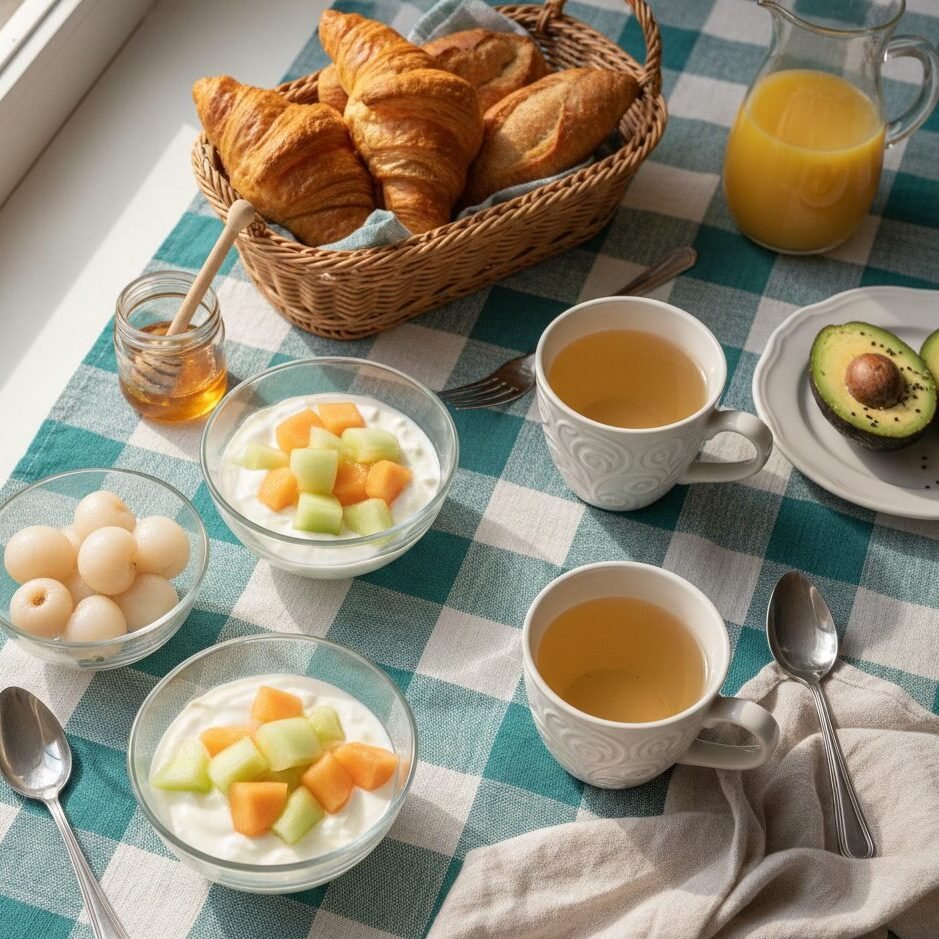
Pair white tea with fruit and yogurt for a fresh start to the morning.
Yogurt’s creamy texture and subtle tang play well alongside the delicate notes of white tea. Choose mild, floral varieties like Nepal White to allow both flavors to shine.
Melon slices or lychee bring out the natural sweetness of the tea without overpowering its gentle character.
Fruits such as melon, lychee, and other tropical options match perfectly with yogurt’s richness and acidity. The combination offers a healthful breakfast that feels light yet satisfying.
This pairing works especially well for those watching caffeine intake.
According to research, white tea contains about 15-30 mg of caffeine per cup, less than black teas or oolong tea blends. Minimal astringency in this type of tea lets it blend easily with smooth dairy textures found in plain Greek yogurt.
Enjoy subtle floral notes from your cup while taking slow bites of chilled fruit for balanced flavor harmony.
Each element enhances the next without crowding your palate. Many experts note that this classic pairing brings balance to both nutrients and taste profiles at any morning table.
White Tea with Light Pastries
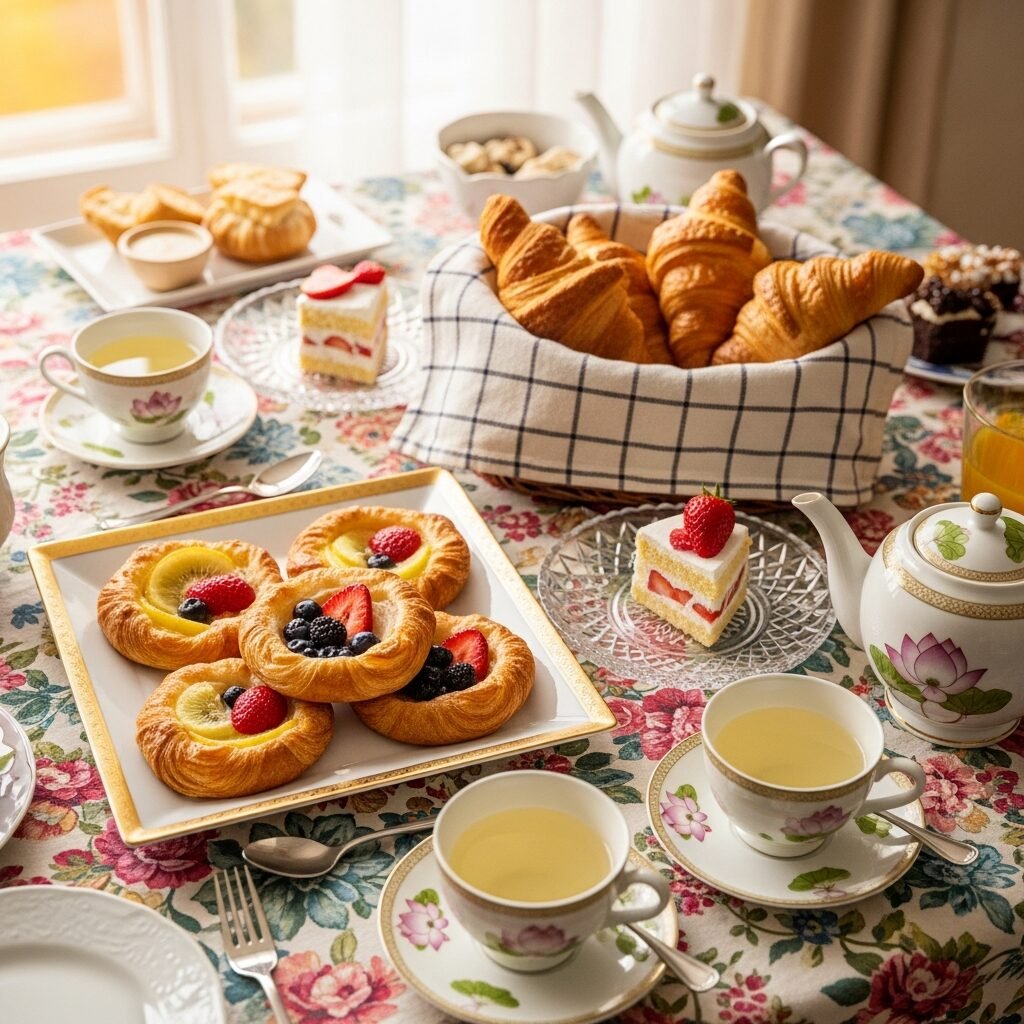
Soft, airy pastries like fruit-filled Danishes, flaky croissants, or a slice of strawberry shortcake bring out the subtle sweetness in white tea.
Mild flavors highlight the delicate floral and hay-like notes typical of Silver Needle or White Peony varieties. The slightly sweet and buttery texture does not overwhelm. Instead, it allows the gentle palate of white tea to shine.
White tea’s lack of bitterness means it goes well with light breakfast treats that are only lightly sweetened.
These simple combinations make breakfast feel fresh and elegant while preserving the natural qualities of each sip.
White Tea with Cucumber Sandwiches
Pair white tea with cucumber sandwiches for a gentle yet elegant breakfast option.
The subtle floral aromas of white tea match perfectly with the fresh, clean taste of sliced cucumber on soft bread. This classic combination preserves the mild flavors that make both the tea and sandwich shine without overpowering your senses or masking delicate notes.
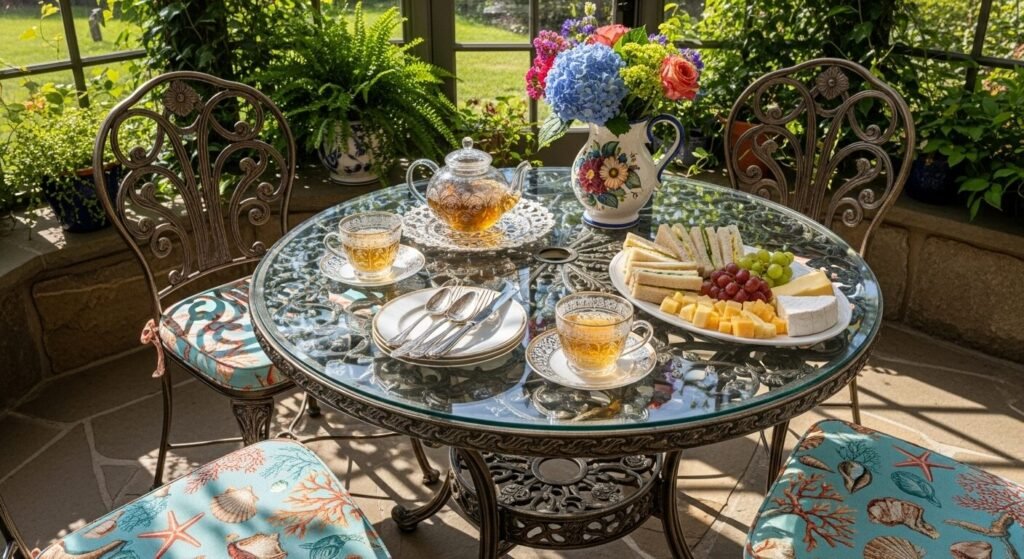
Cucumber sandwiches offer crisp texture which adds contrast to the smooth mouthfeel of a well-steeped cup.
Both foods are low in calories, making them ideal for those who prefer light morning meals that support healthy choices. White tea contributes antioxidants while cucumber provides hydration and vitamins, creating a refreshing pairing suitable for leisurely brunches or sophisticated afternoon teas as recommended by many seasoned tea sommeliers.
What Seafood Goes Best with White Tea?
Delicate white tea can pair well with mild green flavors from fresh seafood.
This creates an artful tea tasting experience that invites you to discover more ideal combinations.
White Tea with Oysters
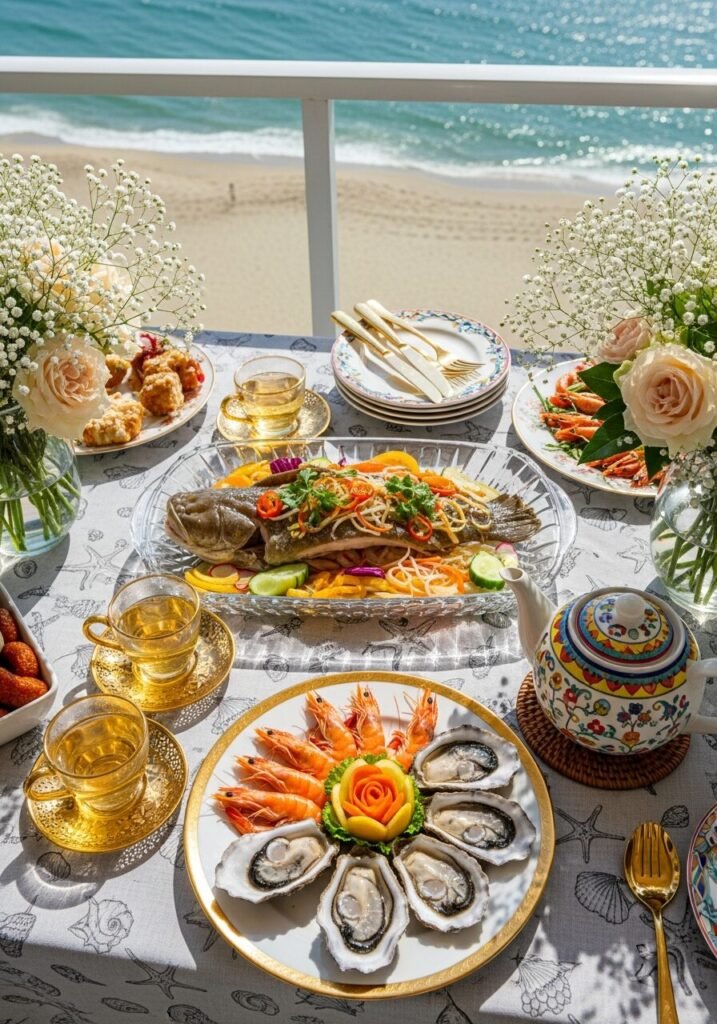
Pairing white tea with oysters creates a refined match for those who appreciate subtle flavors.
Oysters offer a delicate, briny taste that matches well with the floral and hay-like notes of high-quality white teas like Silver Needle. The minimal astringency in white tea allows the oyster’s marine freshness to shine without masking its natural sweetness or saltiness.
As you sip, notice how the white tea acts as a palate cleanser.
This smooth drink washes away lingering flavors, letting each oyster taste pure and clean. For ideal results, choose oysters prepared with little seasoning such as fresh lemon juice or mignonette sauce.
Too much spice or heavy sauces will overpower both the seafood and your cup of tea.
Both connoisseurs and new enthusiasts value this pairing for its elegance at elegant gatherings or quiet afternoons. White tea can be paired easily alongside raw bars at special celebrations. It elevates the experience by highlighting complexity in both food and drink.
White Tea with Steamed Shrimp
Steamed shrimp offers a light, sweet flavor that matches the delicate notes of white tea.
Cooks often prepare the shrimp simply, leaving out heavy sauces or strong spices so the clean taste shines. The natural sweetness in both steamed shrimp and white tea creates an ideal balance for those who want a subtle pairing experience with seafood.
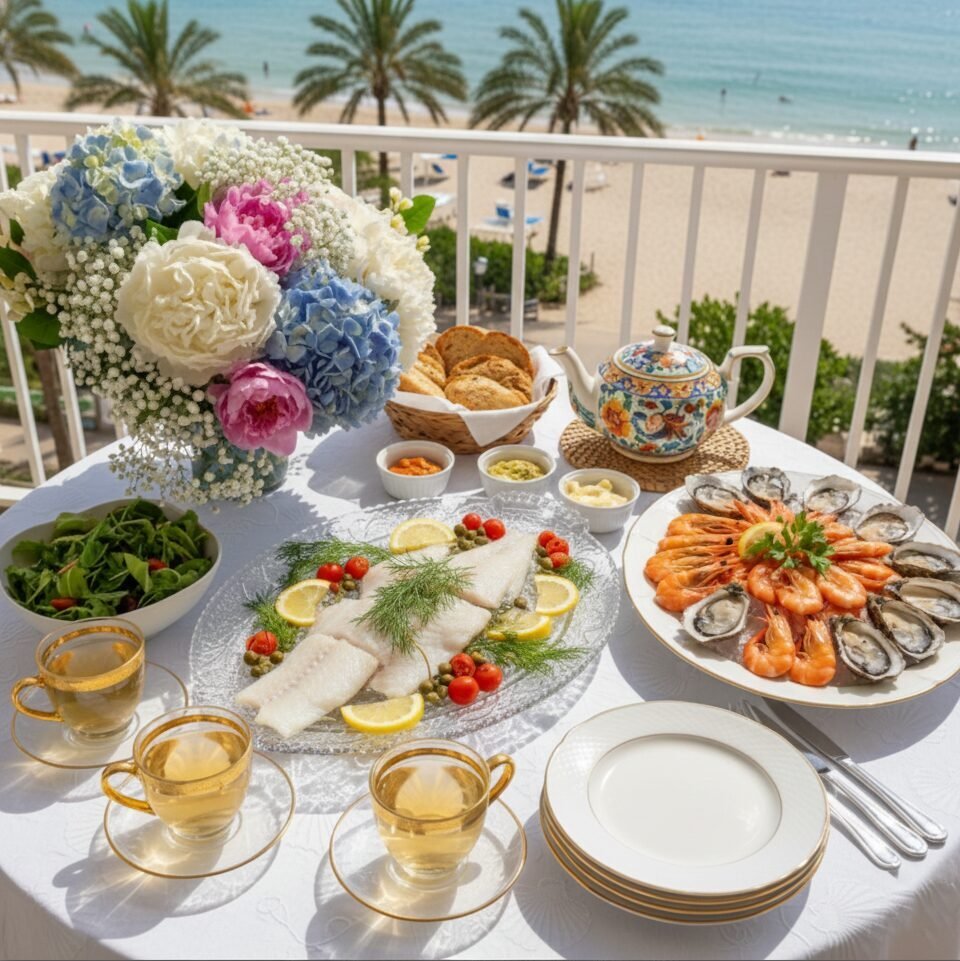
White tea enhances the freshness of steamed shrimp by bringing out its gentle flavors without overpowering them.
Floral and hay-like notes from the tea add depth while keeping each bite refreshing. This combination works well for lunch or dinner, making it a healthful choice in any balanced tea pairing guide.
White Tea with Mild White Fish
Following the gentle pairing of white tea with steamed shrimp, mild white fish such as cod or sole makes an elegant match.
This works for both Silver Needle and White Peony teas. The delicate, slightly sweet taste of these fish highlights the mellow notes in each cup while allowing white tea’s floral and fruity aromas to shine.
Minimal seasoning keeps flavors clean so you can appreciate every subtlety.
Soft textures in mild fish complement the smoothness that defines high-quality white tea. This combination creates a refreshing dining experience perfect for those who enjoy light and refined meals instead of heavy or spiced dishes.
Choose this duo when seeking ways to make a simple meal stand out within your world of tea pairings.
What Desserts Complement White Tea?
White tea complements gentle, sweet desserts and highlights subtle flavors like vanilla or light fruit.
Savoring white tea with the right food enhances each bite and sip, making it a perfect match for those who appreciate the art of pairing.
White Tea with Vanilla-Based Desserts
Pairing vanilla-based desserts with white tea creates a smooth and elegant tasting experience.
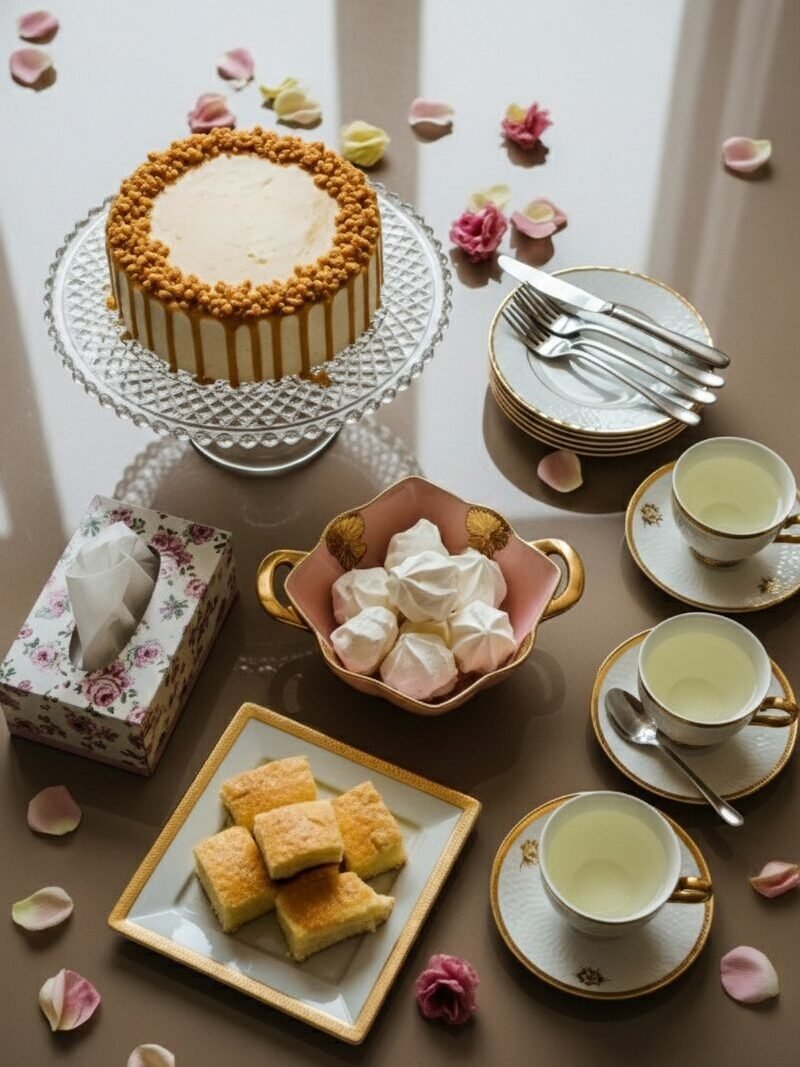
Light, airy treats such as meringues or classic vanilla sponge cakes match well with both Silver Needle and White Peony teas. The mild sweetness of these desserts lets the gentle floral notes of the right tea shine without overpowering them.
Vanilla’s soft aroma enhances subtle fruity flavors found in many types of white tea.
This creates a refined blend that suits both afternoon gatherings and dinner dessert courses. Minimal astringency in these teas allows delicate vanilla flavors to linger on your palate.
Proper brewing brings out those nuanced tones.
This makes it easy for creamy and mild vanilla treats to complement rather than mask the brew. Many people enjoy sipping herbal tea alongside orange-glazed vanilla pastries. This pairing preserves each element’s character while balancing sweetness and fragrance.
Avoid anything too rich or buttery.
Stick with lighter textures for an ideal art of pairing between tea and dessert.
White Tea with Meringues
Light, airy meringues highlight the gentle nature of white tea.
Their mild sweetness pairs seamlessly with floral and hay-like notes in Silver Needle or White Peony varieties. Because both offer minimal astringency, no single flavor competes for dominance. Instead, each sip brings out subtle layers in both dessert and drink.

Tea enthusiasts often select meringues for afternoon tastings or elegant dessert courses.
These treats keep the palate fresh while preserving the integrity of delicate flavors. Proper brewing at lower temperatures ensures your tea remains smooth and fragrant beside each crunchy bite, making it a perfect match for those exploring the art of tea pairing beyond black teas or red tea options.
White Tea with Honey Cakes
Pairing white tea with honey cakes highlights the floral and fruity notes of both.
The natural sweetness of honey matches the subtle flavors of white tea, making it a perfect pairing for those wanting a comforting dessert or breakfast treat. Aged options like Midnight White, known for heavy honey undertones, matched well with honey cakes and create a balance between sweetness and complexity.
White Peony also pairs especially well with these moist desserts.
Its gentle character lets the rich yet mild taste of the cake shine. This combination works smoothly even alongside orange fruit slices or creamy cheese types on the side.
Enjoy this duo to bring out unique aged-tea aromas while savoring each bite and sip together.
White Tea with Lychee and Tropical Fruits
Lychee and tropical fruits highlight the natural fruitiness in white tea.
This makes it a favorite for breakfast or brunch. Slices of melon, papaya, and ripe lychee add a light sweetness that matches the delicate flavor profile of White Peony and Nepal White teas.
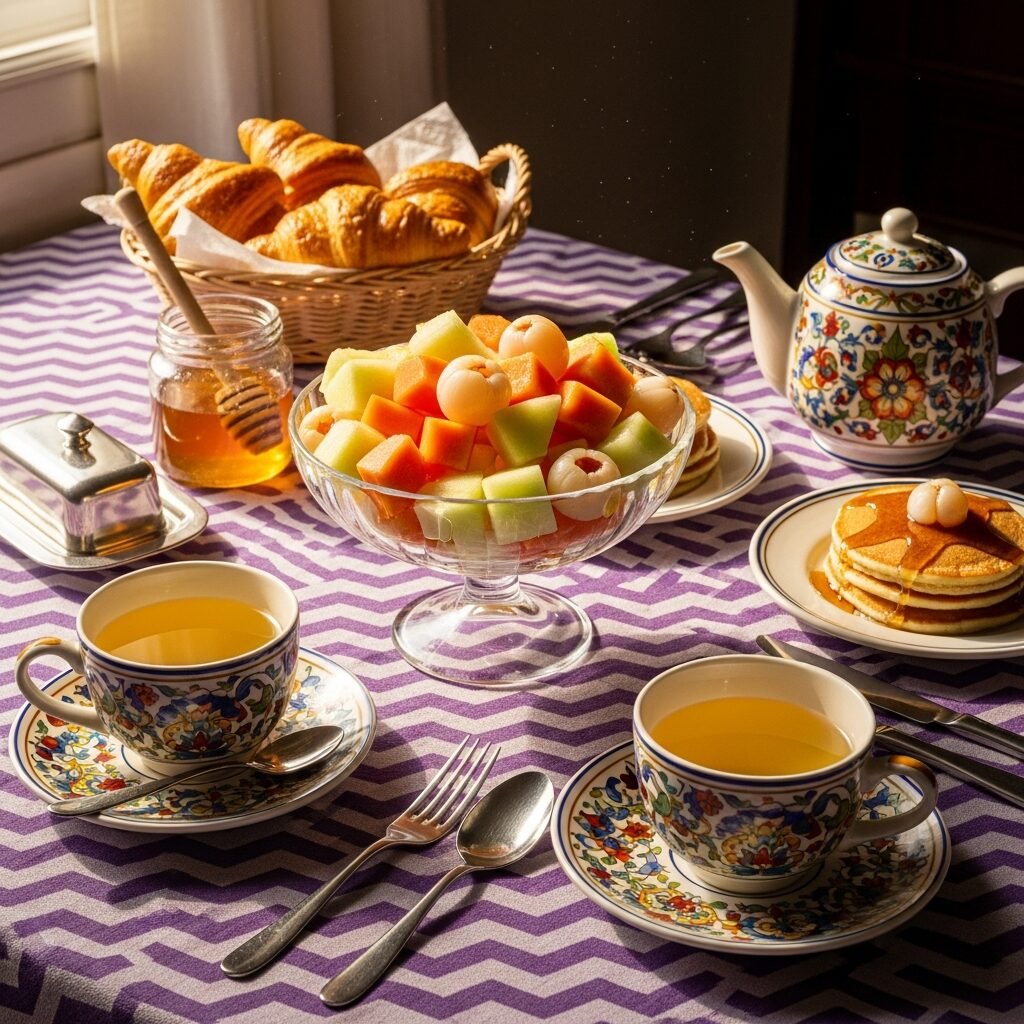
Many find that fresh lychees with their floral aroma blend well with the subtle notes of these teas.
This match enhances both the smooth body of the infusion and its soft finish. Nepal White tea pairs especially well with juicy melon and chunks of sweet mango during summer gatherings.
The minimal astringency in white tea lets these fruits’ flavors shine.
You won’t get overpowered by bitter tones common in green or black teas. Serve this combination chilled for an ideal warm-weather snack or dessert course.
Lychee’s gentle perfume, combined with tropical fruit salads, brings out more floral tones from your cup.
This keeps every bite light yet satisfying.
What Foods Should You Avoid with White Tea?
Some foods can overwhelm white tea’s delicate flavors.
Exploring the right tea with the right pairings will make it a perfect experience. Keep reading for more tips.
Avoiding Overly Spiced Foods
Strong curries, chili-laden sauces, or heavily seasoned dishes make white tea taste flat and dull.
Foods packed with hot spices overpower the delicate floral and hay-like notes found in Silver Needle or White Peony varieties. With almost no astringency, white tea has little bitterness to cut through bold flavors.

Instead, mild snacks like cucumber sandwiches or simple white meat dishes allow the refined palate of the tea to shine.
Pairing white tea with gentle foods preserves its subtle sweetness and fruity hints. Select meals that avoid smoky odors, intense seasonings, and spicy ingredients.
This approach lets you notice every nuance in a cup while enjoying harmonious bites on the side.
Avoiding Heavy or Rich Dishes
Creamy pasta, heavy sauces, and oily foods can mask the gentle floral notes of white tea.
Foods high in fat easily overpower white tea’s delicate palate, making it hard to notice its subtle sweetness or hay-like aroma. Aged cheeses and sharp blue cheese are too intense for this refined brew. Stick to mild fresh types if pairing tea and cheese.
Opt out of regular chocolate with white tea since its richness clashes with the subtle flavor profile.
For those mixing white tea at a tasting, keep cakes buttery but light instead of choosing dense desserts. This careful selection ensures you taste each nuanced note in your cup before moving on to more suitable food pairings that highlight these flavors best.
How to Create a White Tea Tasting Experience
Set the tasting space in a bright, airy area with enough natural light.
This helps you observe the subtle colors of each tea. A room at comfortable temperature helps both white tea and cheese express their best aromas.
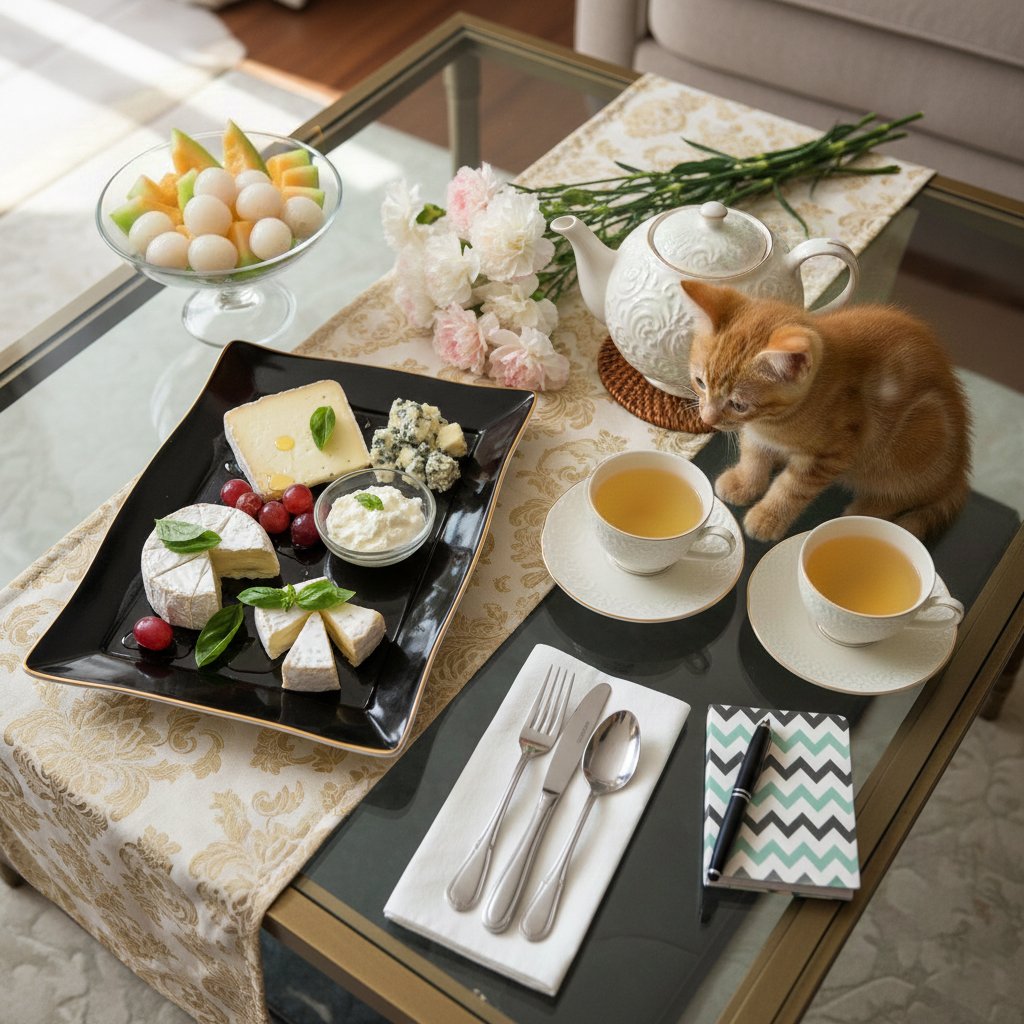
Use professional tasting cups for every participant. Weigh each type of white tea carefully. Heat water just below boiling for Silver Needle or Nepal White and slightly higher for aged Midnight White to draw out nuanced flavors.
Pair three types of cheese with Silver Needle, Nepal White, and Midnight White while assessing appearance, aroma, and taste side by side.
According to brewing experts, water temperature for Silver Needle should be around 185°F (85°C), while aged white teas perform best at 203°F (95°C) to extract deeper complexity. Add slices of orange fruit as palate cleansers between teas or cheeses. This tip sharpens your senses during rounds.
Note how mild cheeses soften hay-like notes or let delicate sweetness shine through the cup.
Keep a modified assessment form handy to jot down observations on flavor pairings like white tea with mint versus classic combinations such as cheddar or brie with black teas. This guides future sessions into even more rewarding discoveries.
Conclusion: Appreciating White Tea Through Thoughtful Pairing
White tea shines brightest with foods that match its delicate nature.
Pair it with light snacks, mild cheeses, or gentle desserts to let its floral notes and subtle sweetness stand out. Whether you sip Silver Needle beside a soft honey cake or mix white tea into a fruity smoothie, each combination adds new depth.
Taste, experiment, and find what flavors excite your palate next to this luxurious tea.
Thoughtful pairings can turn every cup into an occasion worth savoring.
FAQs
1. Why is white tea considered difficult to pair with food, and what is the golden rule for success?
White tea is defined by its delicate, airy sweetness, soft floral notes, and minimal astringency. Because it lacks bitterness and strong tannins, it is easily overpowered by bold flavors. The golden rule for pairing is to select gentle, mild foods—such as soft cheeses, light pastries, or steamed seafood—that enhance the tea’s subtle notes of hay, honeysuckle, and melon rather than masking them.
2. I am planning a breakfast menu; which items work best with white tea?
White tea is an excellent breakfast companion due to its low caffeine content (15–30 mg) and refreshing profile. Ideal pairings include yogurt with tropical fruits like melon or lychee, oatmeal, and cucumber sandwiches. For baked goods, opt for soft, airy pastries like croissants, fruit-filled Danishes, or strawberry shortcake. These items complement the tea’s floral character without weighing down the palate.
3. Can I serve white tea with savory main courses, particularly seafood?
Yes, but the preparation must be kept simple. White tea pairs beautifully with mild seafood that has minimal seasoning. Specific recommendations include steamed shrimp, fresh oysters (with light lemon or mignonette), and mild white fish like cod, sole, or tilapia. The tea acts as a palate cleanser, washing away lingering briny flavors while highlighting the seafood’s natural sweetness.
4. Which specific desserts complement white tea, and which should I avoid?
You should pair white tea with desserts that feature vanilla, honey, or light fruits. Excellent choices include meringues, honey cakes, vanilla sponge cakes, and fruit tarts (strawberry or apricot). Creamy white chocolate is also a perfect match. You must avoid dark chocolate and heavy, rich desserts, as their intensity will completely obliterate the delicate flavor of the tea.
5. How do pairing recommendations differ between Silver Needle and White Peony varieties?
Silver Needle (Baihao Yinzhen) is the most luxurious and delicate variety, featuring notes of melon and pear. It requires the lightest pairings, such as French Beaufort cheese, poached pears, or lemon cream tart. White Peony (Bai Mudan) has a slightly fuller taste as it uses both buds and young leaves. It can handle slightly more substantial pairings, such as steamed tilapia, fresh goat cheese, ricotta, or basmati rice.
6. Are there any foods or ingredients that are strictly “off-limits” when serving white tea?
Yes. You should strictly avoid overly spiced dishes, such as curries or foods with heavy chili sauces, as the heat destroys the tea’s subtle nuances. Additionally, avoid heavy, rich dishes like creamy pastas or oily foods. Strong herbs like ginger and mint should also be avoided, as their assertive flavors will clash with and overpower the tea.
7. How does Aged White Tea differ in flavor and pairing compatibility?
Aged white tea, such as Midnight White, develops deep hay-like notes and pronounced honey aromas over time. Because it is more complex, it can stand up to richer mild foods. It pairs exceptionally well with triple-cream cheeses like Brillat-Savarin, where the buttery texture highlights the tea’s honey accents.
8. What are the optimal brewing parameters to ensure the tea stands up to food?
To ensure the flavor profile is distinct enough to pair with food, proper brewing is essential. For delicate varieties like Silver Needle, use water between 60°F and 185°F (71°C–85°C). For bolder or aged profiles, you can use water up to 212°F (100°C). Always weigh your leaves to ensure the ratio is correct, as oversteeping or weak brewing will disrupt the balance between the food and the drink.





